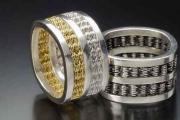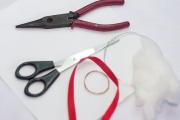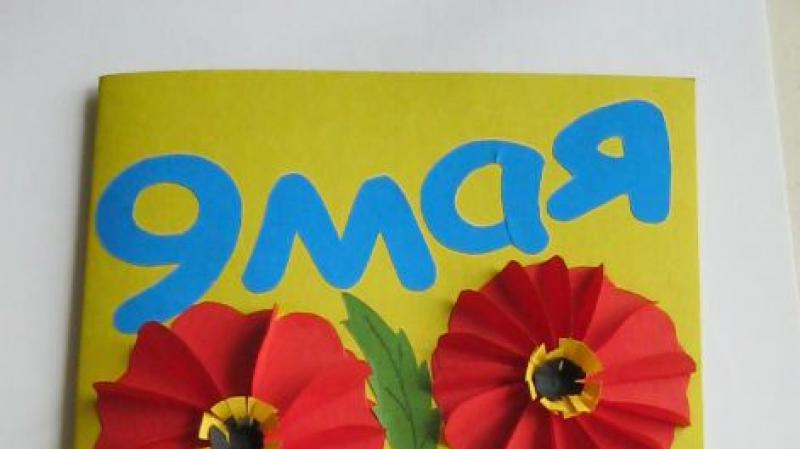How to make a gradient in Photoshop. How to make a gradient manicure at home Gradient manicure for short nails
(on the left) in "one bundle" with the "Fill" bucket and is switched on by the common fast key G. barely noticeable "flow" of one color into another or dense color into a transparent layer.
Tool settings panel
For a bucket in the "Edit" menu, there is a command "Fill", where you can configure its parameters by specifying what color (or pattern) to fill, how to deal with transparent areas, and so on. And the gradient in "Photoshop" colors everything indiscriminately, however, adhering to the frames of the selected area, if any, but no more "conditions" are set for it.
The parameters of the effect, as in all other instruments, are set in the settings panel at the top. Left-clicking on the small triangle next to the thumbnail on the left (or right-clicking on the picture) opens a palette with a predefined set of standard color transitions.
This window has its own menu, which expands by clicking on the gear (or small arrow next to it) in the upper right corner. Here you can select several more "standard" sets, iterating over them with the "Replace Gradients" command, and set the size of the thumbnails, and by default the gradient in "Photoshop" performs a smooth linear transition from the first color to the second.
In the standard sets there are also options for transitions to transparency, but in order for them to work, you need to tick the "Transparency" checkbox, otherwise the picture will be exactly filled with one selected color.
Except options color solutions gradient, in the settings panel you can select its shape (linear, radial, cone-shaped, mirror-like and diamond-shaped).
With the choice of the blending mode and opacity everything is clear, a tick in the "Inversion" box will build the opposite effect. We have dealt with transparency, and the Dithering function, deliberately "noisy" the picture, makes the color transition more natural.
Unlike a bucket fill, to draw a gradient, you need to turn on the tool and select the type of color transition, draw a line in the picture, thereby indicating the start and end points of the effect. After that, the program will fill the document with colors with the selected overflows and in the specified direction.
If you draw a line with the Shift key pressed, the transition can be made strictly vertically, horizontally or at an angle of 45 degrees.
Chief editor for gradient fills
The collection of ready-made effects is presented in ten groups of options, each of which offers from 4 to 16 colors, so the choice is quite decent. But those for whom this is not enough may not worry, since we can create a gradient in Photoshop ourselves.
We opened a window with sets of preset color transitions by clicking on the small arrow next to the effect's thumbnail. And if you click on the thumbnail itself, the "Editor ..." will open, where, using the appropriate settings, we can create our own variations of color overflows without any restrictions.
Photoshop offers two gradient fill modes: Continuous and Noise. The default mode is Continuous, because in most cases, when wondering how to make a gradient in Photoshop, users mean the usual look of the effect with smooth and gradual color transitions.
Building a continuous color transition
The colors are controlled by the sliders (they are also control points, they are markers) at the bottom of the gradient scale, and the upper sliders are responsible for the opacity. A stop is added by clicking on the corresponding border of the effect selection bar.

Clicking on the color / opacity control point activates the paint / opacity selection boxes, the position on the scale (%) and the "Delete" button. At the same time, on both sides of the new marker, the editor places midpoints (diamonds) of color / opacity, "silently" occupying the middle position between adjacent control points, markers, but they can also be moved. At the midpoints of the color, the gradient in Photoshop displays equal mixtures of the starting and ending colors, but the midpoints of opacity hardly need comment.
Colors are selected by double-clicking a control point or color swatch in the Control Points section. If the cursor is inside the gradient selection bar, it turns into an eyedropper, with which you can select a color on the scale or directly on the image.
The "Smoothness" slider controls the smoothness of the transition between multi-colored and multi-colored stripes.
Noisy color transition
A Noise gradient, as opposed to an effect in continuous mode, is a random distribution of colors in a specified range of colors. Depending on the smoothness (roughness), it can look like a "normal" effect with smooth transitions (smoothness / roughness up to 30-40%) or as a variegated, thin-band spectrum (smoothness / roughness up to 90-100%).

In addition to adjusting the smoothness, when creating a transition, you can:
- choose a color model (RGB, HSB, LAB);
- limit colors (for overly saturated colors);
- turn on transparency (for random colors);
- select "Other option" (an effect with arbitrary color transitions is created, but in accordance with the specified settings).
Save the created color transition
If you plan to use the gradient further, Photoshop has thought of everything in this respect.
In order for a new effect to be included in one of the pre-installed (or your own) sets of standard options, you must, before approving the editor's work (Ok), come up with a name for it and enter it in the "Name" text field, and then click the "New" button.
You can "Save" the gradient on your disk as a file with the GRD (Adobe Photoshop Gradient) extension, which will by default go to the Gradients folder in the Presets directory of your version of Adobe Photoshop. From there, new effects are extracted and loaded into the editor.
Gradient fill as a style
You can create (overlay) a drawing (or blank canvas) a gradient in Photoshop from the Layers panel by clicking on the appropriate button at its bottom and choosing the Gradient Overlay style.

In essence and settings, this function does not differ from the fill tool of the color transition. However, here in the Gradient Overlay dialog box you do not need to draw a line manually, and the angle is set either by a radial arrow slider or by entering a numerical value.

"Painless" gradient on the service layer
At the very beginning, it was necessary to make a reservation that it is better to create this effect on a separate new layer, so as not to inadvertently ruin the drawing itself. But for this, in addition to ordinary layers, Photoshop provides utility, or adjustment, layers, the list of which opens with a round black and white button at the bottom of the layers panel.

Among them is the "Gradient" layer, which is similar to the effect window in layer styles, where you can choose a ready-made or build your own color transition, specify a style, select an angle, scale, make an inversion, apply dithering and align to the layer.

How to use a gradient in Photoshop
You can write poems about the irresistibility of such coloring, and if you say it simply and briefly, then it is beautiful. Therefore, it is so popular in decoration art and as a background pattern, but this effect can also be used to apply a tonal transition to a drawing, used as an alpha channel when creating a depth map, in combination with a layer mask, etc.
Posting ads is free and registration is not required. But there is pre-moderation of ads.
Gradient manicure. How to make a gradient on your nails
Bright and unusual color combinations, smooth transitions of shades on the nails - fashion manicure with a gradient effect has not lost its relevance for several seasons. For all the apparent complexity, the gradient manicure technique is quite simple, and making a manicure with a gradient effect at home is quite simple. How to make a gradient on nails - correctly, what techniques for creating smooth color transitions on nails exist and which shades are better to choose, read our article.
What is Gradient Manicure?
Gradient manicure (ombre, degrade) is a kind of decorative nail coating with the effect of a smooth transition of colors. A gradient style manicure can be performed in shades of one color (the color changes its intensity from light to dark), or it can be a transition of two or more colors. Both similar in tone and contrasting shades can be combined - both the one and the other version of the gradient on the nails looks spectacular.


There is another version of the gradient - in this case, each nail on the hand is painted in different shades of the same color, from the lightest to the darkest, or possible gradient manicure in different colors.


Performing a gradient, you can choose any color combination - it all depends only on your imagination. Gradient manicure looks equally good on short nails and on long nails of any shape.
Techniques for performing gradient manicure
A gradient style manicure can be done in several different ways... The gradient on the nails with a sponge is done in the first two ways, and in the third with a brush.
1. The first method is one of the easiest. It requires several shades of nail polish (2 or more), and a small piece of sponge. Stripes of varnish are applied to it in the desired sequence. Then the sponge is gently pressed against the surface of the nail - the colors are transferred to the nail plate. To achieve the maximum brightness of colors, you can first apply a thick white varnish to your nails. Excess color is removed from the skin with nail polish remover, and the nails are covered with a top - a topcoat that sets the color and gives a glossy (or, if desired, matte) finish to the manicure.
Gradient manicure (photo) is performed step by step on each nail:

2. The second method allows you to achieve the most smooth color transitions. Such a gradient is performed step by step: varnishes of different shades are first mixed on a flat surface, and then the colors are transferred to the sponge, and only then to the surface of the nail. This is the most common way to make a gradient manicure with varnish (step by step photo):

3. The third gradient technique eliminates the need for a sponge. This is the most easy way make a transition from one color to another, but it is very difficult to achieve smoothness in this case. The surface of the nail is covered in one or two layers with a base shade varnish, after which it dries to a part nail plate another varnish is applied in the usual way. Gradient manicure with a brush is simple and quick to perform, but often it does not look neat enough.

What is needed to complete a gradient manicure?
To make a gradient with varnish, you will need:
1. Several varnishes of suitable shades. There can be two or more of them - it all depends on your desire.

2. Sponge for gradient manicure. The finer the pores of the sponge, the more accurate and smooth the shade transitions will be. A regular dishwashing sponge will work as well, but it is best to use a cosmetic sponge to apply foundation by cutting it to the required size.

3. Working surface for mixing varnishes - it can be a piece of plastic or film.
4. A toothpick or needle for mixing shades.
5. Liquid for nail polish remover - with its help excess color is removed from the skin around the nail.
6. Finish - top for color consolidation.
How to make a gradient on your nails
It is not difficult to carry out a gradient manicure at home, you just need to prepare everything necessary materials and be patient. It is necessary to perform a gradient manicure step by step:
Step 1
Before making a gradient manicure, you need to take care of the shape of the nails and the skin around them. Give the nails the desired shape with a file and scissors, remove the cuticles and polish the surface of the nail plate, that is, do either a classic edged manicure or a European unedged manicure.

Step 2
Apply a layer of base coat to your nails. It can be a colorless primer, a dense white varnish, or one of the shades used.

Step 3
Apply strips of varnish of different colors on a flat surface so that they touch. Gently mix the colors at the joint with a needle or toothpick.

Step 4
Press a piece of sponge or sponge against the painted surface, and then press the sponge against the nail and transfer the color to it. Try to do this as carefully as possible, in one motion, so as not to smudge the colors.

Step 5
Remove excess nail polish from the skin around your nails with nail polish remover. The easiest way to do this is with a small cotton swab.
Step 6
Wait for the colored finish to dry and cover your nails with a top - it will set the color and prolong the durability of the manicure.
Gradient manicure at home step by step:

Gradient manicure with gel polish and shellac
You already know how to do an ombre and gradient manicure at home yourself using regular nail polishes. But this method has a small drawback - the beauty you have created on the nails will remain for a maximum of a week. What to do if you want to prolong the pleasure of beautiful manicure for a few weeks?
There is a way out - to make a gradient on the nails with shellac or using gel polishes. In this case, a beautiful manicure will delight you for at least three weeks without losing its original characteristics. How to make a gradient manicure with gel polish? The technique of execution in this case does not differ much from the usual one, however, the peculiarities of the properties of resistant coatings require special care, thoroughness and professionalism. In addition, each layer of resistant coating requires UV curing.
Gradient manicure with gel polish (step by step photo)

If you are not sure that you can complete all the steps correctly, you should entrust this work to the master of the nail service, then the result will be of the highest quality.
Gradient on nails with gel polish (photo):

Several gradient nail ideas
We invite you to rate interesting ideas gradient manicure. Perhaps some of them will inspire you to recreate this beauty on your own.

White gradient on nails
The closest "relative" of the French manicure. Delicate transitions of white, cream or light pink colors give the hands a special grace. Perfectly set off a white gradient manicure tan.






Black gradient on nails
The dramatic combination of black and dark scarlet is sure to grab attention in your hands. Black gradient manicure in combination with white color will add rigor and elegance to your nails.







Red gradient manicure
Gradient in shades of red - from bright scarlet to almost black burgundy - ideal for an evening out. You can also make a red gradient on the nails with a transition to other colors.










Pink gradient on nails
The combination of delicate pink shades will suit everyone - from a young girl to an accomplished lady. Pink gradient manicure makes the look feminine and delicate.






Brown gradient manicure


Blue gradient on nails





Blue gradient on nails





Green gradient on nails




Summer gradient manicure
Perform the summer gradient on your nails in bright, juicy neon colors. Even the brightest rainbow on your nails will look great in the sun, by the pool or on the beach.




Gradient glitter manicure


Here are just a few nail gradient ideas. For even more combination options, as well as professional gradient manicure lessons, see the video.
Gradient on the nails with a pattern















Vertical gradient manicure
It is performed in one of the described ways, only the colors are applied not horizontally, but vertically.

Gradient manicure photo tutorial

Gradient manicure for short nails
On short nails, the gradient is the same as on long ones. In this case, it is best to use only two colors and make the transition as smooth as possible.

Gradient manicure: photo













Gradient manicure rainbow










Now you know how to make a gradient manicure at home. Any manicure requires training, so don't be upset if your first experience isn't perfect. Experiment with colors, try different techniques- and soon you will be able to get a result indistinguishable from a professional one. Video tutorials of beauty bloggers and professional nail service masters will help you to perform the gradient manicure as correctly as possible.
Today we are going to talk about everyone's favorite - the gradient. It is also called ombre, degrade, stretching. There are many names, but the essence is the same - a smooth, and sometimes not very, transition from one color to another. Ombre manicure always attracts the admiring glances of others, and it also visually lengthens the nails. For the smoothest gradient, use analog colors that are adjacent in the color wheel (two, three, or even four adjacent colors). However, an analog color scheme is not necessary at all. You can use any color scheme you like.
A simple white gel polish or the lightest of those colors that you use serves as a base for nail design with a gradient. But if the gel varnishes are sufficiently pigmented, then you can not apply the base color at all. The layers of gel polish will cover the nail anyway. And do not forget that the numb or smeared gel polish must first be wiped off and only then sent to dry in the lamp.

To create the gradient in the first way, we need a flat synthetic brush with a straight or semicircular tip (you can use the one with which you apply the base).
- Choose two shades of gel polish and paint over a full nail with each color. We recommend making the layers thin enough for easier shading.
- Take a flat brush and wet it in a cleanser to keep it slightly damp. Then lightly, without pressure, run it several times from the cuticle to the tip. Keep the brush almost parallel to the nail so that it does not strip the gradient, but smooths it smoothly. When the transition has become soft, send the nail to dry in the lamp.
- Apply a second coat (two shades full of nails). Again soften the transition with a flat brush dipped in cleanser. Between the steps, clean the brush with a cloth dampened in the cleaner.
- Apply a third layer to make the gradient more saturated.
Create a gradient with a fan brush

In this case, the color transition is not so smooth, but this method is quite easy and you can quickly create a gradient manicure at home.
- As a base, apply the most light color from the gradient (in one or several layers, depending on its density). Dry in the lamp.
- On foil, mix two colors for a medium shade and apply to the middle of the nail. This will be the transition area.
- Below, almost at the tip, apply a dark color.
- Take a slightly damp brush soaked in cleanser and brush it from side to side in one place until you get the desired effect.
- Dry in the lamp.
- Apply a second coat, repeating what you just did. Now apply the main color only to the upper part of the nail so that it does not overlap the gradient. Dry in the lamp.

- Apply a base coat (or white backing if the pigment may not cover the nail) on the nails and cure in the lamp.
- Next, use the Petal Brush to apply the pigment from the cuticle, stretching it towards the color mixing area. Press lightly so as not to pull the pigment off a piece of the sticky layer. You need to achieve a solid color at the base and translucency in the middle.
- Peel the brush on a napkin and do the same with the second layer, choosing the second pigment color and moving from the edge to the middle. The layer should be thin but dense.
- Top with top and pat dry.
In this case, you will need a well-washed and dried sponge for washing dishes with small pores, cut into pieces (make it high enough so that it is easier to control pressure). The makeup sponge absorbs too much gel polish and leaves a very thin, weightless layer. To protect the cuticle, it can be sealed with tape or covered with PVA glue, and at the end of the manicure, peel off the layer along with unnecessary gel polish.
Method number 1

- Apply the design base to the nail. Dry in the lamp.
- Place two drops of gel polish at a short distance (white and colored) on the foil. Mix the intermediate color between them with a toothpick or dots.
- Apply the sponge to the varnish until it absorbs it. To avoid bubbles, place the first 2-3 prints on foil.
- Transfer the gel polish to the nail with soft but springy movements in the required number of layers until the shade is what you want.
- Cover with a top and dry in a lamp.
Method number 2

- Apply design base and dry.
- Then, in a thick layer, apply two colors on the nail, joint to joint.
- Quickly blot the nail with a sponge with light movements, but with pressure. Reduce the pressure as the tone evens out to get rid of the bubbles. Do not rush to dry so that the gel polish has time to lie down and even out a little. Take care of the rest of the marigolds for now. Random bubbles can be removed with a toothpick.
- Apply the second coat in the same way. The number of layers depends on the desired effect and the materials used.
- Top with top and pat dry.
Advice: if you don't get a smooth gradient, then just sprinkle the color mixing area with transparent sparkles. So your manicure will become brighter, and only you will know about its small flaw.

You will need:
- any shade of gel polish at will
- white gel polish
- thin brush
- foil or palette for mixing colors
Instructions:
- Apply a layer of white gel polish and cure in the lamp. Peel off the sticky layer.
- Next, draw the edging of the marigold with the main color, trying to make the same width everywhere. The excess can be touched up with a liquid to remove the sticky layer with a brush. Dry in the lamp.
- For the next stripe, mix the base color and white. Draw a stripe in a joint with the previous one, trying to make it the same width. Dry in the lamp.
- For the next stripe, mix an even lighter shade and paint another stripe in the seam. Dry in the lamp.
- At the penultimate stage, you need to mix the shade even lighter, draw a strip and dry it.
- Draw the last straight line in white.
- Dry and apply the top without a sticky layer. Dry again in the lamp.
Now you are convinced that you can create a gradient on your nails with gel polish even at home. Of course, you need a bit of perseverance and patience, but the result is worth it. Learn, master new techniques, and don't be afraid to experiment. Give yourself and others the opportunity to enjoy your beautiful ombre manicure.
The gradient stretching method is very popular now. It is used when creating stylish clothes and accessories, hair coloring, eye and lip makeup. A fashionable phenomenon has also affected manicure: the smooth flow of colors allows you to create a bright and unusual nail design, which, depending on the selection of shades, looks appropriate both at a youth party and at a business meeting. Working with varnishes is more difficult than with lipstick or eyeshadow, but now there are quite a few ways to make an ombre on your nails yourself.
What is a gradient in manicure
The ombre technique is also known as degrade, stretch, or gradient manicure. Its essence lies in staining nails with varnishes of several shades in such a way that there is a smooth transition between them, and not a clear border. At the same time, colored stripes can be located vertically, horizontally, diagonally - the scope of imagination is not limited by anything.
A special type of gradient manicure is stretching over the entire hand, when the thumbnail is painted in one color, the little finger in another, and the rest in intermediate shades. This ombre is easy to make, but it looks very impressive.
Degrade can be drawn on artificial and natural nails any length and shape, so no additional manipulations in the form of extensions or trimming are required. In addition, the nail plate after gradient staining looks longer and narrower, which is successfully used by girls who want to give their fingertips a more elegant look.
In a manicure, you can mix varnishes of different colors, arrange them as you like, decorate with drawings or rhinestones. It is enough to study one or several ways of doing stretching, and then exclusive ideas will last for a lifetime.
Important! In ombre manicure, varnishes of different textures are not combined, so pearlescent should be mixed only with pearl, cream - with cream, jelly - with jelly.
What you need for an ombre manicure at home
The correct selection of tools and materials is already half the success, so first you have to acquire everything you need. A lot is probably already in home cosmetic bins, and the missing accessories are easy to buy in the store or order on the Internet. Some things can be done at all from improvised means.
Gradient stretching is performed with both conventional and gel polishes, so that every fashionista can work with those materials that are more familiar and more convenient for her.
If you plan to paint a manicure with ordinary varnishes, then you will need the following:
- for pretreatment of nails: scissors, a file, a cuticle softener, an orange stick or a manicure hoof, a protective coating for varnish;
- for coloring: colored varnishes and a transparent glossy top;
- for stretching: pieces of a sponge, a palette (a piece of plastic, cardboard, foil, saucer, plastic lid or any other object), toothpicks;
- auxiliary means: cotton buds, nail polish remover, correcting pencil, cuticle protective fluid, tweezers.
Those who prefer shellac or gel polishes will need the following set of tools:
- for nail preparation: the same things as in the previous list, plus a polishing buffer, degreasing solution or dehydrator;
- for coloring: base gel, several colors and top coat;
- for stretching: palette, sponges, toothpicks, manicure brushes;
- for drying: UV or LED lamp;
- auxiliary means: cuticle protector, lint-free wipes, cleanser to remove the sticky dispersion layer.
Reference! Gel polish and shellac are different things, but in many ways similar. Shellac is the first hybrid product to combine the properties of gel and varnish. It was created and patented by the American company CND. Other cosmetic brands have started to copy the idea, striving to surpass the original, so their versions of gel polishes can differ in composition, price, wearing period, methods of application and removal, color palette and other properties. On nails, however, all of these products look about the same, so any is suitable for a gradient manicure.
How to choose a sponge
The main tool for creating a gradient manicure is a sponge. Most often, an ordinary kitchen is used, because such equipment is always present on the farm and at the right time is at hand.
Colored pieces of foam rubber have another plus - they are very cheap, and since after all the manipulations the sponge is usually not washed, but thrown away, the economic benefit from their use is obvious.
Unfortunately, the kitchen sponge also has disadvantages. Foam rubber is a coarse-mesh material, so the line of transition of shades turns out to be grainy and uneven. To smooth it, you need to press the sponge to the nail several times, which is why small air bubbles appear in the varnish layer.
This can be avoided by controlling the intensity and number of prints, however craftsmanship comes with experience. Those who have just started to master the ombre manicure will have to practice in order to perform a beautiful stretch with a piece of foam rubber.
Another option is to buy a latex sponge, which is usually used for foundation. It is the same elastic, but its pores are smaller, so the varnishes mix more evenly, there are almost no bubbles, and the gradient is smooth and natural.
The only drawback of the instrument is the price. A set of high-quality cosmetic sponges costs several times more than a package of foam rubber for washing dishes. There are also cheaper latex sponges, but they are best avoided. They are too soft, so it will be awkward to print the gradient. In addition, they absorb a lot of varnish and begin to crumble already in the process of working, leaving small torn pieces on the nail.
In addition to sponges, fashionistas have mastered foam applicators for shadows. You can't draw a complex multicolor gradient with them, but you can make, for example, a neat blurry jacket using the ombre technique.
The cosmetics industry could not ignore the increasing need for gradient manicure tools, so two varieties of specialized sponges appeared on the market. The first is an elongated triangle of foam latex. It is comfortable to hold in your hand and can be gradually shortened by cutting off the edge painted with varnishes. The second type is a round sponge that is attached to a plastic base that looks like a stamping stamp. The sponge is made of finely porous foam, so it does a good job of blurring the gradient.
Important! Both latex and foam sponges can be washed off after use. Regular varnish is removed with a liquid remover or acetone, and gel varnish - with a special cleaning solution or alcohol. Solvents will hardly damage sponges, so you can calculate the cost of both and choose the most profitable option.
Ombre manicure at home: step by step instructions
When the shades are selected and everything you need is prepared, you can start working. The sequence of actions is due to the type of cosmetic product used to create a manicure: regular varnish, gel varnish or shellac.
Manicure with ordinary varnishes
Simple varnishes require speed, since they set in the air, but their advantage is that an unsuccessful gradient can be quickly erased and a new one can be applied immediately.
- The creative process begins with the preparation of the nails. You need to remove the old manicure from them, adjust the shape, if necessary, get rid of excess length. If time permits, you can make a hand bath. Then you should take care of the cuticle: treat it with a remover or gently push it back with an orange stick.
- After that, wipe the nails with a nail polish remover to degrease, remove sawdust and residual cuticle softening liquid.
- The next step is to apply a special base. There are many varieties of these remedies. They protect the nail from harmful substances in the composition of the colored coating, and also smooth the surface and facilitate the application of varnish. This step, of course, can be skipped if desired, but in nail salons it has long been compulsory.
- The fourth step is drawing the gradient. This is the hardest part of the whole process. There are several ways to create a smooth color transition with ordinary varnishes, but they will be discussed in detail below.
- The finishing touch is the application of a glossy transparent top. It evens out the rough surface of the painted nail, and also slightly dissolves the dried layer of varnish and, due to this, blurs the border between the shades.
Ways to create a gradient
There are three ways to paint an ombre manicure and all require a sponge.
- The easiest option: first the traditional way paint the nail with varnish of the color that will be near the cuticle. When the product dries, take a sponge, make one or two strokes on its edge with a second shade of varnish and press it to the tip of the nail. Distribute the paint with a few patting movements, drawing the gradient to the desired level. In this way, it is most convenient to draw an ombre of two colors, for example, a blurred jacket. However, if you wish, you can add a third.
- For the second method, you need a palette. On it, apply short strips of the selected varnishes so that they touch each other, and mix the boundaries of contact with a toothpick. Do not spare the paint, otherwise it will dry out quickly. There can be two, three or even four colors, if the length of the nails allows. By the way, in this way it is convenient to combine contrasting varnishes, creating the necessary intermediate shade between them. When the gradient on the palette is ready, press the sponge against it so that it absorbs the paint, and then print on the nail with a few patting movements. In this case, the sponge can be slightly shifted perpendicular to the colored stripes for better blurring, for example, up and down if the drawing is horizontal.
- The third method differs from the previous one by the absence of a palette: stripes of paint are applied directly to the sponge and immediately imprinted on the nails. So it turns out faster, which is especially important for quick-drying varnishes. As necessary, the strips are renewed, preventing them from hardening, and the nails on both hands are painted in the same way. There can be two, three or more shades, but it is better not to take contrasting colors or make the first two or three prints on paper. So the paints can mix in the pores of the sponge and the stretch on the nail will be more uniform.
Advice! It is often recommended to make a substrate of white varnish under the gradient. It does make the colors look brighter, but you have to work very hard to completely hide the white background. Places at the cuticle and lateral ridges are usually poorly stained with a sponge, so they will have to be additionally treated with a brush or tweezers with a small piece of sponge.
Video: how to make a gradient manicure using a sponge
Manicure with gel polishes
Gel polishes seem to be created for the embodiment of complex artistic ideas: they do not dry out in the air, so the stretch can be corrected until the result is satisfied. The process of creating a manicure is more complicated than in the previous case, but the gradient is smoother and more accurate.
- The first step is similar to the one described earlier and consists of preparing the nails, shaping them and removing the cuticles.
- The next stage is buffing the nail plate. You don't need to be especially zealous, just remove the upper glossy layer. This will help level the surface and allow the gel to adhere better.
- Prepared nails are wiped with a degreaser or dehydrator. Both solutions perform similar functions, and the choice is due to the physiological characteristics of the body. Those with frequent sweaty hands should prefer a dehydrator, because it not only removes grease, moisture and dust from the nail plate, but also dries it deeply. For everyone else, a degreaser is enough. After this treatment, you can no longer touch the nails with your fingers.
- Next, the nails are covered with a layer of primer, which provides better adhesion to the gel, and also has antibacterial properties. For gel polishes, acid-free products are preferable, since they are less aggressive. The primer is not dried in the lamp: as soon as the nail turns white, the process can be continued.
- The fifth step is to apply a base transparent gel to the entire surface of the nail and its ends. The product is spread in a thin layer and dried in a lamp for the time specified in the instructions. It may differ from manufacturer to manufacturer, but the requirements must be observed in order to avoid flaking of the colored coating. After drying, the sticky layer is removed with a lint-free cloth.
- The nails are now ready to paint the gradient. In the case of gel polishes, there are even more ways to make ombre, and they will be discussed in detail below.
- The final stage of the process is the application of the top. When the drawing on the nails is ready, it remains only to cover it with a layer of finishing gel, polymerize in a lamp and erase the sticky dispersion. An important nuance: The ends of the nails must be sealed with varnish to prevent delamination and prolong the life of the manicure.
Reference! In the case of shellac, the sequence of actions is almost the same. You can only skip the stage of polishing the nail plate and processing with a primer, since the base gel is allowed to be immediately applied to the natural, fat-free nail.
Gradient options
The ways described above to draw an ombre manicure with a sponge are also relevant for gel polishes. There is only one additional condition: to get a rich color and a neat smooth stretch, you will have to make several prints with a sponge on the nail. Each print must be dried in a lamp and the dispersion removed. In this case, the layers should be thin, since otherwise the varnish will lie unevenly and waves, bubbles, bald spots will appear on it.
Ombre on the nails can be painted not only with a sponge, but also with a brush. This tool is a little more difficult to work with, as it requires jewelry precision, but the gradient will turn out to be very smooth and natural. There are three ways to create a trendy manicure using a brush.
- Gradient with a flat brush. For work, you need a flat brush with elastic short bristles and a lint-free cloth soaked in a cleanser. The creative process is as follows: apply all the selected varnishes on the nail with a thin layer, placing the colored stripes as close as possible. They may even touch or flow over each other. Lightly moisten a clean brush in a cleanser and run it along the junction of shades, blurring the border. Make several such movements so that the transition becomes smoother, and dry the first layer in the lamp. Then wipe the brush on a napkin, removing excess paint, and repeat the operation. In the process of work, the tool should be held almost parallel to the nail and pressed very carefully so that the gradient turns out to be blurry, and not striped. Dry the second layer and, if necessary, apply the third in the same way. Usually three times it is enough to get bright colors and a soft transition between them.
- Gradient with a fan brush. It is best to use this tool to stretch from three shades, when the middle one is intermediate between the other two. To begin with, completely paint the nail plate with the first varnish, which will be near the cuticle, then dry the coating and remove the sticky layer. Then, separately on the palette, mix both colors equally to get an intermediate one, and apply it to the middle of the nail. Paint the tip with a second varnish, and then take a slightly damp fan brush and, holding it flat and moving from side to side parallel to the border of shades, blur the transition zone. Dry the first layer and repeat the manipulations until the desired result is achieved.
- Ombre with acrylic powder. First, the nails need to be painted in the base color. This can be, for example, white, which makes any other shades brighter. Beige tones or the lightest of those in the gradient are also suitable. Dry the painted nail in a lamp, and then apply acrylic powder directly to the sticky layer. Any dry and clean brush is suitable for this purpose. She also blend the borders between the colors, adding a little pigment if necessary. Shake off excess powder with another clean brush, cover the gradient with a top and dry in a lamp.
These were the most famous ways to paint ombre manicure using brushes. In reality, there are more options, but they are all based on the three listed. For example, you can stretch with sequins, make stripes of different widths, arrange them diagonally, or completely abandon the stripes and paint the nail with colored highlights.
Video: how to make a gradient manicure with gel polishes
Five Fingers Gradient Manicure
This is a very simple but effective type of ombre manicure. It can be painted with regular and gel varnishes, and from additional devices you only need a palette, a clean brush and a napkin soaked in cleanser or remover.
Sequencing:
- apply the first color to the thumbnail;
- mix with a brush on the palette a drop of the first varnish and a drop of the second, with the resulting shade cover the nail of the index finger;
- mix a drop of the first and two drops of the second varnish, paint the nail of the middle finger;
- mix a drop of the first and three drops of the second varnish, apply on the nail of the nameless;
- paint the nail on the little finger with a second varnish.
Additional tricks
A beautiful and neat ombre manicure is a difficult task, but doable. If you know some tricks, then you will be able to achieve the desired goal almost the first time.
How to get rid of bubbles
This problem occurs for everyone who paints a manicure with a sponge. To avoid the appearance of bubbles, you need to adhere to the following rules:
- do not press hard on the sponge so that only paint is squeezed out of its pores, and not air, which becomes the cause of trouble;
- the sponge can be slightly moistened with water. Moisture does not interact in any way with either varnish or gel, but it occupies part of the pores in the sponge, displacing air from there;
- the first two or three prints must be printed on paper. So the paint will be absorbed deeper, and with subsequent presses less air will come out.
How to protect your fingers from staining
This is another nuisance characteristic of ombre manicure. If you can still paint it neatly with a brush, then both the nail itself and the skin around it are painted over with a sponge. The following means are used to protect the fingers:
- PVA glue. It's affordable, safe, easy to apply, and quick to remove. When drawing a manicure, it is distributed in a generous layer over the skin around the nail, and when it dries up, they start working with colored varnishes. At the end of the procedure, the adhesive film is removed with tweezers along with the hardened paint;
- film masks for the face. The principle of operation is the same;
- special products to protect the cuticle and skin around the nail. They are a liquid that solidifies into a film in air. He of the previous two products, they are distinguished by convenient packaging (bottle with a brush), the presence of useful substances in the composition and, of course, the price;
- Scotch. This is the least convenient protection, because it is difficult to cut a piece that fits into the shape and size of the adhesive tape. In addition, the varnish still drips under it, so the skin will have to be wiped off anyway.
Important! On the Internet, there are often tips to apply a layer of greasy cream to the cuticles and side rollers, but this cannot be done. This is especially true for those who use gel polishes and diligently degrease their nails to prevent flaking. Ordinary varnishes are not so capricious in this regard, but the manicure will also be short-lived if a portion of the cream from the fingers is absorbed into the sponge with paint.
How to match shades
For a beautiful ombre manicure, it is very important to choose the right varnishes, since in case of an error, the gradient will turn out to be dirty and sloppy even with perfect blurring of the borders. A win-win option is a combination of shades of the same color, different in saturation, for example, beige and coffee. Also, the tones located next to the color wheel look good: yellow with orange, blue with blue. If such a circle is not at hand, then you can focus on the alternation of rainbow stripes.
In manicure, it is allowed to combine contrasting shades, but it is better to do this using an intermediate color, otherwise the transition zone will turn out to be uneven. For example, if you want to make a gradient from blue to red, then add a purple stripe in the middle.
Online services, of which there are quite a few now, will help you to unmistakably select varnishes for manicure. Another reliable tool is Itten's color wheel. This gadget is sold in art stores, but the easiest way to find it is on the Internet.
Ombre manicure is good because it has no restrictions in terms of working with color. In this technique, you can create combinations for any occasion: to the office, to a date and even to a carnival. At the same time, the most strict and restrained drawing will not look boring and banal, since the gradient gives the color depth and expressiveness. It is worth mastering the technique if only because only two shades of varnish allow you to come up with at least a dozen ideas for manicure, and the creative possibilities of the owners of more extensive varnish collections are truly endless.
Gradient manicure (another name for it is ombre) is a nail design in which different shades varnishes smoothly flow from one to another.
Unfortunately, it is difficult to create such beauty on your own, but having filled your hand, you can perform simple options for this manicure on your own. And our step by step instructions will help.
We prepare materials for work
We will do a gradient manicure at home, so we will completely do without professional tools.
Prepare:
- Foam sponge. One that is intended for washing dishes will do.
- New transparent plastic bag, stationery file or foil.
- Several toothpicks.
- Base coat for varnish.
- Securing coating.
- Tint varnishes.
- Nail polish remover, cotton pads, sticks or special pencils to remove excess nail polish.
For the first time, it is better to use two colors, as applying more shades requires honed skills. It can be two different but matching colors or two shades of the same color. It is very difficult to work with chameleon varnishes, therefore, when creating a gradient manicure at home, they should be abandoned.
Keep in mind that gradient manicure involves a lot of varnish consumption.
Cut out small pieces from the sponge in advance - about one and a half centimeters wide and three to four centimeters long.

Preparing nails
Before applying a gradient manicure, carefully treat your nails to give them a neat and well-groomed look. These are standard procedures: filing and polishing, removing cuticles, degreasing the surface with nail polish remover.
After that, apply the base and wait for it to dry. It can be either a special base varnish or some colorless medical varnish (such as "Smart enamel").
Method one
Lay out the package (stationery file or foil) on the table. Apply the lightest varnish all over the nail.

While the layer is drying, make two blobs of the varnish of your choice on the surface of the bag or foil. The droplets must be in contact with each other. Use a toothpick to blur the lines between them.
Apply the sponge to the stain and immediately thereafter to the surface of the nail. Make sure that the arrangement of the colors on the sponge matches the one you want to get on your nails.

Blend the color with light, pressing movements. Repeat this step if necessary. Do not be afraid to stain the skin around the nail, all excess can be removed later.
Repeat the procedure for all nails.

Apply a protective coating. You can use a clear glitter varnish.
After drying, clean the stained skin with a special pencil or a cotton pad soaked in nail polish remover.
Varnishes can be applied directly to the sponge. Do not spare the coloring material. Apply enough so that it can be well imprinted on the surface of the nail.
It is advisable to have a few pieces of sponge in stock in case one begins to crumble during the staining process.
If a gradient manicure is performed using matte varnish, then there should not be any particular difficulties. If the varnish is glossy, then it may cloudy when you stretch it with a sponge. If this happens, you will need to cover the nail with several layers of anchoring coat.
Method two
The principle is the same, but instead of a sponge, an applicator (sponge) is used to apply eye shadow. The skin will get a little less dirty than when using a regular piece of foam rubber, and it is more convenient for someone to blend the color with the applicator stick.
But, in general, do not be afraid to get dirty when doing a gradient manicure. The skin is easily cleaned with a nail polish remover, but if you are too careful, you may not paint over the entire surface of the nail, it will turn out ugly.
Method three
If you still dare to make more than two colors, then you can apply the required number of shades to the sponge or proceed as follows.
- Apply base color all over the nail.
- After the first layer has dried, apply the second color with a sponge from about the middle of the nail plate. Try to make the border between the colors a little blurry.
- With another piece of sponge, apply a third coat to the outer edge of the nail, making sure that the border is smeared.
- Apply a sealer coat.
Method four
Suitable if you want to get a vertical gradient manicure.

- Apply two (or more) shades of varnish to the nail in stripes so that the borders between them meet.
- Quickly, before the varnish begins to dry, with a sponge, soften the boundaries between the flowers by lightly patting.
- Repeat steps 1 and 2 as needed.
- Apply a top coat.
What problems can arise
If you don't get a smooth transition between colors, then you may have chosen too contrasting shades. We'll have to find another combination. Alternatively, try overlaying multiple layers, letting each layer dry a little.
If bubbles appear after the sponge is printed, use a finer-grained sponge. If this does not help, then after applying varnish on it, make prints first on foil or paper, and then on the nail.
If this does not work, then simply increase the number of layers of varnish on the nail. Then the dots will become invisible.

Using gel polish for gradient manicure
A gradient manicure with shellac or gel polish looks more impressive, and lasts much longer than when using conventional coating... The technique is similar, but if you do not have special equipment and cosmetics, then it is better to do this procedure in the salon.
Manicure-gradient gel polish is performed as follows:
- The nails are degreased with a dehydrator.
- An acid-free primer is applied. Then the base, which is baked for a minute under a UV lamp.
- A lighter gel polish is applied from the base of the nail to the middle. The rest is painted over dark shade... The joint line should be straight.
- The border between colors is blurred with a thin paint brush or sponge.
- After erasing the borders, the nails on each hand are dried under a lamp for one and a half to two minutes.
- If it is necessary to obtain a more saturated shade, steps 3-5 are repeated.
- The painted feet are covered with a fixing gel polish and dried again under the lamp.

Benefits of gradient manicure
The gradient manicure looks unusual, gives a zest and is appropriate in any setting, provided correct selection flowers. The coating can be done with both bright and pastel colors... For the same reason, manicure is suitable for women and girls of all ages.
Despite the rather complicated execution technique, “smearing” varnish is undoubtedly easier than drawing flowers, patterns or letters with it. Once you learn how to paint your nails this way, you can choose from a wide variety of options. After all, you can endlessly look for interesting color combinations, and each time the manicure will look in a new way.














